TheDeveloperBlog.com
C-Sharp | Java | Python | Swift | GO | WPF | Ruby | Scala | F# | JavaScript | SQL | PHP | Angular | HTML
C++ Inheritance
C++ Inheritance tutorial for beginners and professionals with examples on constructor, if-else, switch, break, continue, comments, arrays, object and class, exception, static, structs, inheritance, aggregation etc.
C++ InheritanceIn C++, inheritance is a process in which one object acquires all the properties and behaviors of its parent object automatically. In such way, you can reuse, extend or modify the attributes and behaviors which are defined in other class. In C++, the class which inherits the members of another class is called derived class and the class whose members are inherited is called base class. The derived class is the specialized class for the base class. Advantage of C++ Inheritance
Code reusability: Now you can reuse the members of your parent class. So, there is no need to define the member again. So less code is required in the class. Types Of Inheritance
C++ supports five types of inheritance:
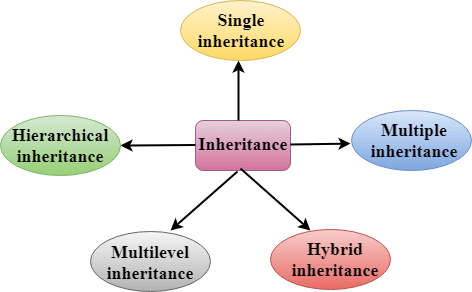
Derived Classes
A Derived class is defined as the class derived from the base class. The Syntax of Derived class:
class derived_class_name :: visibility-mode base_class_name
{
// body of the derived class.
}
Where, derived_class_name: It is the name of the derived class. visibility mode: The visibility mode specifies whether the features of the base class are publicly inherited or privately inherited. It can be public or private. base_class_name: It is the name of the base class.
Note:
C++ Single InheritanceSingle inheritance is defined as the inheritance in which a derived class is inherited from the only one base class. 
Where 'A' is the base class, and 'B' is the derived class. C++ Single Level Inheritance Example: Inheriting FieldsWhen one class inherits another class, it is known as single level inheritance. Let's see the example of single level inheritance which inherits the fields only.
#include <iostream>
using namespace std;
class Account {
public:
float salary = 60000;
};
class Programmer: public Account {
public:
float bonus = 5000;
};
int main(void) {
Programmer p1;
cout<<"Salary: "<<p1.salary<<endl;
cout<<"Bonus: "<<p1.bonus<<endl;
return 0;
}
Output: Salary: 60000 Bonus: 5000 In the above example, Employee is the base class and Programmer is the derived class. C++ Single Level Inheritance Example: Inheriting MethodsLet's see another example of inheritance in C++ which inherits methods only.
#include <iostream>
using namespace std;
class Animal {
public:
void eat() {
cout<<"Eating..."<<endl;
}
};
class Dog: public Animal
{
public:
void bark(){
cout<<"Barking...";
}
};
int main(void) {
Dog d1;
d1.eat();
d1.bark();
return 0;
}
Output: Eating... Barking... Let's see a simple example.
#include <iostream>
using namespace std;
class A
{
int a = 4;
int b = 5;
public:
int mul()
{
int c = a*b;
return c;
}
};
class B : private A
{
public:
void display()
{
int result = mul();
std::cout <<"Multiplication of a and b is : "<<result<< std::endl;
}
};
int main()
{
B b;
b.display();
return 0;
}
Output: Multiplication of a and b is : 20 In the above example, class A is privately inherited. Therefore, the mul() function of class 'A' cannot be accessed by the object of class B. It can only be accessed by the member function of class B. How to make a Private Member InheritableThe private member is not inheritable. If we modify the visibility mode by making it public, but this takes away the advantage of data hiding. C++ introduces a third visibility modifier, i.e., protected. The member which is declared as protected will be accessible to all the member functions within the class as well as the class immediately derived from it. Visibility modes can be classified into three categories: 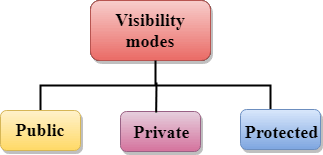
Visibility of Inherited Members
C++ Multilevel InheritanceMultilevel inheritance is a process of deriving a class from another derived class. 
C++ Multi Level Inheritance ExampleWhen one class inherits another class which is further inherited by another class, it is known as multi level inheritance in C++. Inheritance is transitive so the last derived class acquires all the members of all its base classes. Let's see the example of multi level inheritance in C++.
#include <iostream>
using namespace std;
class Animal {
public:
void eat() {
cout<<"Eating..."<<endl;
}
};
class Dog: public Animal
{
public:
void bark(){
cout<<"Barking..."<<endl;
}
};
class BabyDog: public Dog
{
public:
void weep() {
cout<<"Weeping...";
}
};
int main(void) {
BabyDog d1;
d1.eat();
d1.bark();
d1.weep();
return 0;
}
Output: Eating... Barking... Weeping... C++ Multiple InheritanceMultiple inheritance is the process of deriving a new class that inherits the attributes from two or more classes. 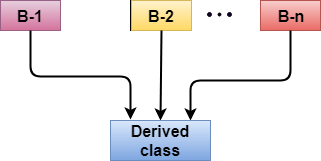
Syntax of the Derived class:
class D : visibility B-1, visibility B-2, ?
{
// Body of the class;
}
Let's see a simple example of multiple inheritance.
#include <iostream>
using namespace std;
class A
{
protected:
int a;
public:
void get_a(int n)
{
a = n;
}
};
class B
{
protected:
int b;
public:
void get_b(int n)
{
b = n;
}
};
class C : public A,public B
{
public:
void display()
{
std::cout << "The value of a is : " <<a<< std::endl;
std::cout << "The value of b is : " <<b<< std::endl;
cout<<"Addition of a and b is : "<<a+b;
}
};
int main()
{
C c;
c.get_a(10);
c.get_b(20);
c.display();
return 0;
}
Output: The value of a is : 10 The value of b is : 20 Addition of a and b is : 30 In the above example, class 'C' inherits two base classes 'A' and 'B' in a public mode. Ambiquity Resolution in InheritanceAmbiguity can be occurred in using the multiple inheritance when a function with the same name occurs in more than one base class. Let's understand this through an example:
#include <iostream>
using namespace std;
class A
{
public:
void display()
{
std::cout << "Class A" << std::endl;
}
};
class B
{
public:
void display()
{
std::cout << "Class B" << std::endl;
}
};
class C : public A, public B
{
void view()
{
display();
}
};
int main()
{
C c;
c.display();
return 0;
}
Output: error: reference to 'display' is ambiguous
display();
class C : public A, public B
{
void view()
{
A :: display(); // Calling the display() function of class A.
B :: display(); // Calling the display() function of class B.
}
};
An ambiguity can also occur in single inheritance. Consider the following situation:
class A
{
public:
void display()
{
cout<<?Class A?;
}
} ;
class B
{
public:
void display()
{
cout<<?Class B?;
}
} ;
In the above case, the function of the derived class overrides the method of the base class. Therefore, call to the display() function will simply call the function defined in the derived class. If we want to invoke the base class function, we can use the class resolution operator.
int main()
{
B b;
b.display(); // Calling the display() function of B class.
b.B :: display(); // Calling the display() function defined in B class.
}
C++ Hybrid InheritanceHybrid inheritance is a combination of more than one type of inheritance. 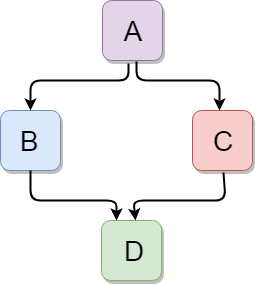
Let's see a simple example:
#include <iostream>
using namespace std;
class A
{
protected:
int a;
public:
void get_a()
{
std::cout << "Enter the value of 'a' : " << std::endl;
cin>>a;
}
};
class B : public A
{
protected:
int b;
public:
void get_b()
{
std::cout << "Enter the value of 'b' : " << std::endl;
cin>>b;
}
};
class C
{
protected:
int c;
public:
void get_c()
{
std::cout << "Enter the value of c is : " << std::endl;
cin>>c;
}
};
class D : public B, public C
{
protected:
int d;
public:
void mul()
{
get_a();
get_b();
get_c();
std::cout << "Multiplication of a,b,c is : " <<a*b*c<< std::endl;
}
};
int main()
{
D d;
d.mul();
return 0;
}
Output: Enter the value of 'a' : 10 Enter the value of 'b' : 20 Enter the value of c is : 30 Multiplication of a,b,c is : 6000 C++ Hierarchical InheritanceHierarchical inheritance is defined as the process of deriving more than one class from a base class. 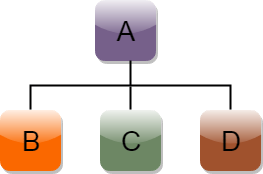
Syntax of Hierarchical inheritance:
class A
{
// body of the class A.
}
class B : public A
{
// body of class B.
}
class C : public A
{
// body of class C.
}
class D : public A
{
// body of class D.
}
Let's see a simple example:
#include <iostream>
using namespace std;
class Shape // Declaration of base class.
{
public:
int a;
int b;
void get_data(int n,int m)
{
a= n;
b = m;
}
};
class Rectangle : public Shape // inheriting Shape class
{
public:
int rect_area()
{
int result = a*b;
return result;
}
};
class Triangle : public Shape // inheriting Shape class
{
public:
int triangle_area()
{
float result = 0.5*a*b;
return result;
}
};
int main()
{
Rectangle r;
Triangle t;
int length,breadth,base,height;
std::cout << "Enter the length and breadth of a rectangle: " << std::endl;
cin>>length>>breadth;
r.get_data(length,breadth);
int m = r.rect_area();
std::cout << "Area of the rectangle is : " <<m<< std::endl;
std::cout << "Enter the base and height of the triangle: " << std::endl;
cin>>base>>height;
t.get_data(base,height);
float n = t.triangle_area();
std::cout <<"Area of the triangle is : " << n<<std::endl;
return 0;
}
Output: Enter the length and breadth of a rectangle: 23 20 Area of the rectangle is : 460 Enter the base and height of the triangle: 2 5 Area of the triangle is : 5
Next TopicC++ Aggregation
| |||||||||||||||||||
Related Links:
- C++ set key_comp() Function
- C++ set value_comp() Function
- C++ set find() Function
- C++ set count() Function
- C++ set lower_bound() Function
- C++ set upper_bound() Function
- C++ set equal_range() Function
- C++ set get_allocator() Function
- C++ set operator==
- C++ set operator!=
- C++ algorithm iter_swap() function
- C++ multiset equal_range() function
- C++ Program to Convert Number in Character
- C++ Program to Print Alphabet Triangle
- C++ Vector back() function
- C++ Program to Print Number Triangle
- C++ algorithm search() function
- C++ Program to Generate Fibonacci Triangle
- Top 39 C++ Interview Questions (2021)
- C++ multiset lower_bound() function
- C++ multiset upper_bound() function
- C++ multiset get_allocator() function
- C++ multiset operator==
- C++ algorithm adjacent_find() function
- C++ algorithm any_of() function
- C++ multiset non member operator greater than=
- C++ multiset swap() function
- C++ multiset operator!=
- C++ algorithm copy() function
- C++ algorithm remove_if() function
- C++ algorithm reverse_copy() function
- C++ algorithm copy_if() function
- C++ Math llrint() Function
- C++ Math tgamma() Function
- C++ Math lgamma() Function
- C++ Math nearbyint() Function
- C++ Math remainder() Function
- C++ Math remquo() Function
- C++ Math fabs() Functions
- C++ Math abs() Functions
- C++ Math fma() Function
- C++ Math fpclassify() Function
- C++ Math isgreaterequal() Function
- C++ algorithm count() function
- C++ algorithm count_if() function
- C++ algorithm equal() function
- C++ algorithm find_if() function
- C++ algorithm all_of() function
- C++ algorithm copy_backward() function
- C++ algorithm copy_n() function
- C++ algorithm is_permutation() function
- C++ algorithm mismatch() function
- C++ algorithm none_of() function
- C++ algorithm swap() function
- C++ algorithm fill() function
- C++ algorithm replace_copy_if() function
- C++ algorithm replace_copy() function
- C++ algorithm replace_if() function
- C++ algorithm transform() function
- C++ algorithm fill_n() function
- C++ set crend() Function
- C++ set empty() Function
- C++ set size() Function
- C++ set max_size() Function
- C++ Output Iterator
- C++ Programs
- C++ algorithm move_backward() function
- C++ algorithm reverse() function
- C++ algorithm find_if_not() function
- C++ Math isfinite() Function
- C++ Math isinf() Function
- C++ multiset operator less than
- C++ multiset non member operator less than=
- C++ multiset non member operator greater than
- C++ Math isnan() Functions
- C++ Math isnormal() Function
- C++ Math signbit() Function
- C++ Math isgreater() Function
- C++ Math less() Function
- C++ Math isunordered() Function
- C++ Math erf() Function
- C++ Math erfc() Function
- C++ set cbegin() Function
- C++ set end() Function
- C++ String rbegin() function
- C++ algorithm random_shuffle() function
- C++ algorithm remove_copy_if() function
- C++ Vector front() function
- C++ set
- C++ Stack
- C++ Queue
- C++ Stack empty() Function
- C++ Stack pop() Function
- C++ Queue emplace() Function
- C++ Queue empty() Function
- C++ Queue front() Function
- C++ algorithm is_sorted_until() function
- C++ algorithm is_sorted() function
- C++ algorithm rotate_copy() function
- C++ algorithm rotate() function
- C++ Stack push() Function
- C++ Stack size() Function
- C++ set swap() Function
- C++ set clear() Function
- C++ set emplace() Function
- C++ set emplace_hint() Function
- C++ algorithm merge() function
- C++ algorithm set_union() function
- C++ Queue pop() Function
- C++ Math cos() Function
- C++ Queue push() Function
- C++ set insert() Function
- C++ set erase() Function
- C++ algorithm find() function
- C++ Math sin() Function
- C++ Queue size() Function
- C++ multiset
- C++ Math tan() Function
- C++ Math log10() Function
- C++ String compare() function
- C++ Math acos() Function
- C++ String length() function
- C++ Math asin() Function
- C++ String swap() function
- C++ multiset constructor
- C++ Math atan() Functions
- C++ String size() function
- C++ set operator less than
- C++ set operator less than=
- C++ set operator greater than
- C++ Math atan2() Function
- C++ String resize() function
- C++ String replace() function
- C++ multiset clear() function
- C++ multiset emplace() function
- C++ multiset erase() function
- C++ multiset destructor
- C++ multiset begin() function
- C++ multiset end() function
- C++ multiset operator= function
- C++ multiset rbegin() function
- C++ multiset crbegin() function
- C++ algorithm partial_sort() function
- C++ algorithm sort() function
- C++ multiset swap() function
- C++ multiset rend() function
- C++ multiset cbegin() function
- C++ multiset cend() function
- C++ multiset emplace_hint() function
- C++ multiset find() function
- C++ History
- C++ Features
- C++ set operator greater than=
- C++ set swap() Function (Non-member)
- C++ String max_size() function
- Turbo C++ - Download and Installation
- C++ Program
- C++ Basic Input Output (cin, cout, endl)
- C++ Variable
- C++ Object Class
- C++ Vector rbegin() function
- C++ Data types
- C++ Keywords
- C++ Vector clear() function
- C++ Vector max_size() function
- C++ Operators
- C++ if-else
- C++ switch
- C++ For Loop
- C++ While Loop
- C++ Math cosh() Function
- C++ Do-While Loop
- C++ Math sinh() Function
- C++ Break Statement
- C++ Math tanh() Function
- C++ Continue Statement
- C++ Math acosh() Function
- C++ Goto Statement
- C++ Math asinh() Function
- C++ Math atanh() Function
- C++ Comments
- C++ Math exp() Function
- C++ Math frexp() Function
- C++ Math log() Function
- C++ Functions
- C++ Math modf() Function
- C++ Recursion
- C++ Storage Classes
- C++ Forward Iterator
- C++ Input Iterator
- C++ Math exp2() Function
- C++ multiset key_comp() function
- C++ algorithm unique_copy() function
- C++ Math llround() Function
- C++ Arrays
- C++ Passing Array to Function
- C++ Multidimensional Arrays
- C++ Pointers
- C++ OOPs Concepts
- C++ Constructor
- C++ Copy Constructor
- C++ Destructor
- C++ algorithm upper_bound() function
- C++ this Pointer
- C++ static
- C++ Structs
- C++ Enumeration
- C++ friend function
- C++ Math Functions
- C++ Inheritance
- C++ Aggregation
- C++ Polymorphism
- C++ Overloading
- C++ algorithm lower_bound() function
- C++ Vector
- C++ Math expm1() Function
- C++ Math log1p() Function
- C++ Math log2() Function
- C++ String append() function
- C++ Tutorial | Learn C++ Programming
- C++ multiset crend() function
- C++ multiset empty() function
- C++ multiset insert() function
- C++ Math logb() Function
- C++ String at() function
- C++ Math scalbn() Function
- C++ String find() function
- C++ Math scalbln() Function
- C++ String find_first_of() function
- C++ algorithm replace() function
- C++ algorithm swap_ranges() function
- C++ Math ilogb() Function
- C++ String find_first_not_of() function
- C++ Math copysign() Function
- C++ String find_last_of() function
- C++ Math nextafter() Function
- C++ String find_last_not_of() function
- C++ Math nexttoward() Function
- C++ String insert() function
- C++ String push_back() function
- C++ String assign() function
- C++ algorithm search_n() function
- C++ algorithm generate_n() function
- C++ String copy() function
- C++ algorithm find_end() function
- C++ algorithm find_first_of() function
- C++ algorithm generate() function
- C++ algorithm remove() function
- C++ algorithm is_partitioned() function
- C++ String begin() function
- C++ String cbegin() function
- C++ String cend() function
- C++ String clear() function
- C++ String crbegin() function
- C++ Function Overriding
- C++ virtual function
- C++ vs C#
- C++ Convert int to string
- C++ Components of STL
- C++ String Data() function
- C++ String empty() function
- C++ Algorithm
- C++ Iterators
- C++ Bidirectional Iterator
- C++ Namespaces
- C++ Strings
- C++ String erase() function
- C++ Stack emplace() Function
- C++ Exception Handling
- C++ String front() function
- C++ vs Java
- C++ try-catch
- C++ String operator+=() function
- C++ multiset value_comp() function
- C++ multiset count() function
- C++ User-Defined Exceptions
- C++ Templates
- C++ Signal Handling
- C++ File and Stream
- C++ String operator=() function
- C++ String operator[]() function
- C++ String rfind() function
- C++ String end() function
- C++ String capacity() function
- C++ String shrink_to_fit() function
- C++ String crend() function
- C++ algorithm shuffle() function
- C++ algorithm stable_partition() function
- C++ String reserve() function
- C++ String pop_back() function
- C++ Vector at() function
- C++ String c_str() function
- C++ Vector swap() function
- C++ Vector push_back() function
- C++ Vector pop_back() function
- C++ Vector empty() function
- C++ set destructor
- C++ set operator=() Function
- C++ set begin() Function
- C++ Vector insert() function
- C++ Stack top() Function
- C++ Queue back() Function
- C++ Vector erase() function
- C++ String back() function
- C++ String rend() function
- C++ Vector resize() function
- C++ Vector size() function
- C++ Vector capacity() function
- C++ Math islessgreater() Function
- C++ Vector assign() function
- C++ Vector operator=() function
- C++ Vector operator[]() function
- C++ Vector end() function
- C++ Vector emplace() function
- C++ Vector emplace_back() function
- C++ Vector rend() function
- C++ Vector begin() function
- C++ Vector cend() function
- C++ Vector cbegin() function
- C++ Math fdim() Function
- C++ Vector crbegin() function
- C++ Math fmax() Function
- C++ Vector crend() function
- C++ Math fmin() Function
- C++ Vector data() function
- C++ Vector shrink_to_fit() function
- C++ Math pow() Function
- C++ algorithm unique() function
- C++ Math sqrt() Function
- C++ Math cbrt() Function
- C++ Math islessequal() Function
- C++ Math hypot() Function
- C++ Math ceil() Functions
- C++ algorithm for_each() function
- C++ multiset max_size() function
- C++ multiset size() function
- C++ Math floor() Function
- C++ set constructor
- C++ Math round() Function
- C++ algorithm equal_range() function
- C++ algorithm includes() function
- C++ algorithm inplace_merge() function
- C++ Math lround() Functions
- C++ algorithm partition_copy() function
- C++ algorithm partition_point() function
- C++ algorithm partition() function
- C++ Math fmod() Function
- C++ Program to Reverse Number
- C++ Math trunc() Function
- C++ Program to Swap Tow Number Without Third Variable
- C++ algorithm stable_sort() function
- C++ algorithm binary_search() function
- C++ Math rint() Function
- C++ Program to Convert Decimal to Binary
- C++ Math lrint() Function
- C++ algorithm nth_element() function
- C++ algorithm partial_sort_copy() function
- C++ set cend() Function
- C++ set rbegin() Function
- C++ set rend() Function
- C++ set crbegin() Function
- C++ algorithm move() function
- C++ algorithm remove_copy() function


